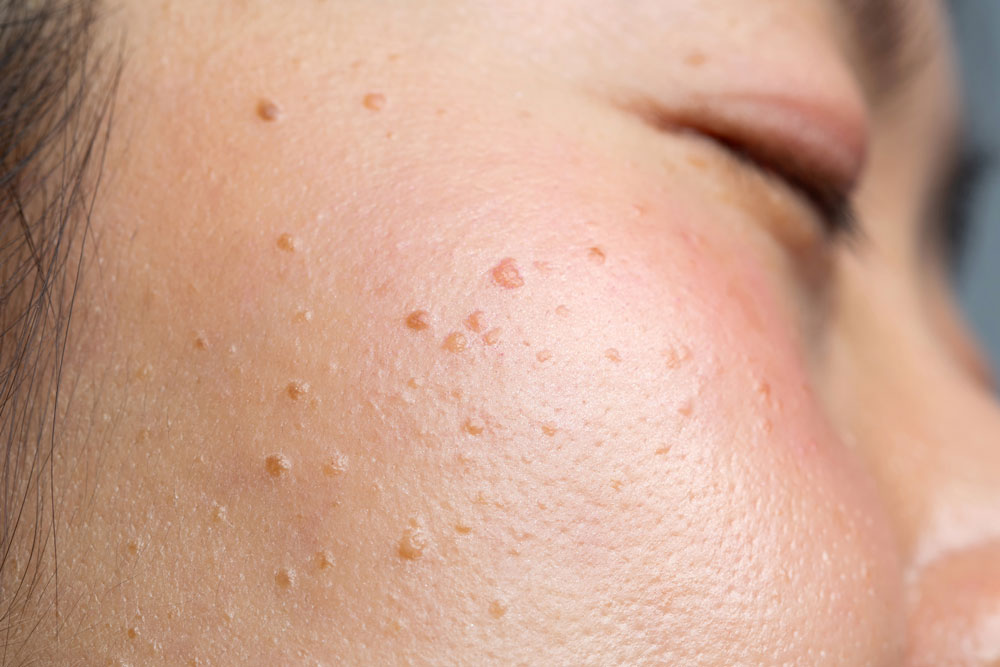Seborrheic keratosis is a common non-cancerous skin growth that often appears as people age. It is estimated that 80 million Americans have one or more of these growths on their skin, and almost all adults over the age of 60 have one or more growths on their body. While these benign and painless growths are minor, they can cause cosmetic dissatisfaction. Sometimes, seborrheic keratosis can be mistaken for other skin conditions due to their potentially dark and scaly nature. Proper diagnosis by one of our dermatologists or experienced clinicians is essential. Let’s dive in to read more about this skin growth and what to do if you have it.
What Are the Signs and Symptoms of Seborrheic Keratosis?
Seborrheic keratoses are slow-growing and may appear as a small, rough bump at first but can grow to larger than the size of a quarter. They typically appear round or oval, are slightly raised with a scaly surface, and range in color from light tan to brown or black. Sometimes, they can develop white or black dots on the surface, giving them a warty appearance. Seborrheic keratoses are found either as one growth or many in one area. They usually grow on the face, scalp, back, under the breasts, arms, and legs.
One way to describe seborrheic keratoses is that they appear as if they were dripped onto the skin by a candle. While these growths are not painful, they can be itchy and are often irritated if rubbed by clothing or jewelry.
What Are the Causes and Risk Factors of Seborrheic Keratosis?
The cause of seborrheic keratosis is not entirely understood. While there are multiple possible changes in the body that may contribute to the development of these growths, there are several risk factors that we know about:
- Over 50 years old
- Family history of seborrheic keratosis
- Lighter skin tones
- Sun exposure
- Times of hormonal changes, such as pregnancy or menopause.
Scientists have also found that genetic mutations may contribute to the development of seborrheic keratosis. These include the fibroblast growth factor receptor 3 (FGFR3) and PIK3CA mutations. If you or a family member has a history of these genetic mutations, please let us know.
How Is Seborrheic Keratosis Diagnosed?
When a lesion or growth on the body develops, the most important part of the diagnosis is to rule out cancer, such as malignant melanoma, so getting checked by one of our experienced clinicians is important. Seborrheic keratosis is usually diagnosed by clinical observation on a dermatoscope, where our clinicians can visualize the growth’s distinct features. If we are unsure, the most definitive course of action is to take a biopsy to rule out other skin conditions, such as cancer.
What Are the Treatment Options for Seborrheic Keratosis
Treatment is usually not required as these growths are benign. However, most patients will receive some form of treatment for cosmetic reasons and if the seborrheic keratoses are being irritated by clothing. It is crucial to consult with one of our trained clinicians to see which treatment plan is best for you. Treatment options include:
- Cryotherapy: Similar to removing a wart, cryotherapy is the most common and the easiest treatment for seborrheic keratosis. Liquid nitrogen, or CO2, is applied to the growth to rapidly freeze the cells, resulting in the cells’ death. The growth will then fall off in a few days or, depending on its size, may require further cryotherapy sessions.
- Curettage: This method uses a specialized tool to scrape and remove the growth at the superficial level once the skin has been numbed.
- Electrocautery: Electrocautery is the use of heat to remove the seborrheic keratosis. The skin is numbed, and a small, heated probe is used to burn the growth off.
- Laser Therapy: Laser treatments employ the use of concentrated and specific light beams to remove the lesion. The lasers break down the cells of the growth, where the body later eliminates it. Laser therapy is typically used for larger surface areas or thicker growths that have not responded to other treatments.
Prevention and Management of Seborrheic Keratosis
Unfortunately, it is not possible to prevent seborrheic keratosis in its entirety. Regular skin examinations by one of our dermatologists or other experienced clinicians can help aid in early detection and management. As sun exposure is one of the risk factors, protecting the skin from excessive sun exposure can help reduce the risk of skin cancer and premature aging. We recommend using at least SPF 30 daily (even in cloudy weather or winter) and wearing protective clothing when in the direct sun.
When to See a Doctor About Seborrheic Keratosis
Many clients with seborrheic keratosis won’t need medical intervention. However, if the growth bothers you physically or cosmetically, contact one of our dermatologists to schedule an appointment. Additionally, make an appointment if you notice the following:
- A sudden new growth
- An existing growth that changes in its appearance, such as color or size, or starts to look different from other seborrheic keratoses
- The growth is irritated and uncomfortable
Do not try to remove a seborrheic keratosis growth yourself as there is a risk of infection.
Visit Worcester Dermatology Associates for Help
Seborrheic keratosis is a common and non-cancerous skin condition that many over the age of 50 experience. By understanding its characteristics and treatment options, you can become more informed on managing your skin health. If you notice any new growths, or lesions, or are concerned about the ones you have, contact our office to make an appointment with one of our dermatologists or experienced clinicians to ensure proper diagnosis and peace of mind.

